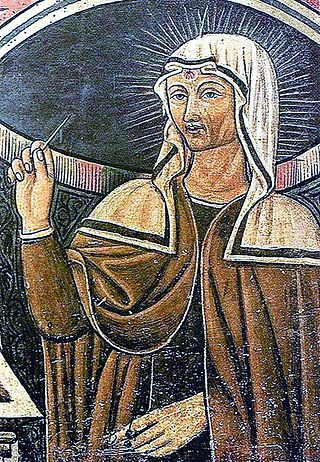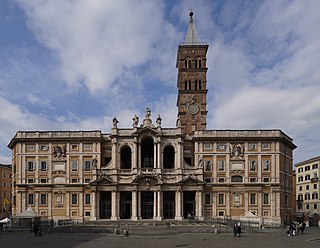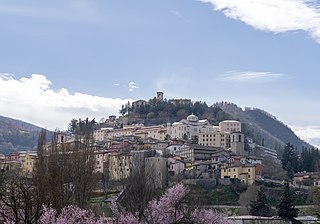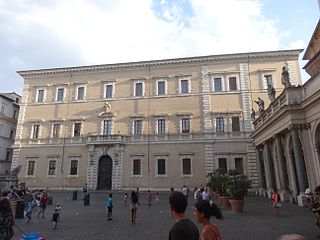
The Basilica of Santa Rita da Cascia is a 20th-century Roman Catholic minor basilica church, sanctuary, and convent located in the town of Cascia, province of Perugia, region of Umbria, Italy.

The Basilica of Santa Rita da Cascia is a 20th-century Roman Catholic minor basilica church, sanctuary, and convent located in the town of Cascia, province of Perugia, region of Umbria, Italy.
The basilica was built in the early twentieth century to provide a larger church to house the much visited relics of the former nun, Saint Rita of Cascia, who was canonized in 1900. The initial impulse was guided by the Abbess Maria Teresa Fasce, now considered a blessed individual by the Roman Catholic church. Lacking the money for the construction of a church, some funds were initially raised by subscriptions to a journal titled Dalle Api alle Rose and a donation by Pope Benedict XV. In 1931, the Pope Pius XI added further funding, and a plan was elaborated by the engineer Maria Spirito Chiapetta, and the architects Giuseppe Calori and Giuseppe Martinenghi. The first stone was deposited on June 20, 1937, by cardinal Enrico Gasparri, and construction concluded in 1947. In 1955, Pope Pius XII elevated the church to the rank of a minor basilica. [1]
The facade of the basilica is dressed with white travertine from Tivoli. The layout is centralized in the form of a Greek cross. The portal is sculpted by Eros Pellini with scenes from the life of Santa Rita. The interior has extensive fresco work, completed by Luigi Montanarini, Luigi Filocamo, Silvio Consadori, Gisberto Ceracchini and Cesarino Vicenzi. The main altar was designed by Giacomo Manzù. [2]

Assisi is a town and comune of Italy in the Province of Perugia in the Umbria region, on the western flank of Monte Subasio.

Rita of Cascia, OSA, was an Italian widow and Augustinian nun. After Rita's husband died, she joined a small community of nuns, who later became Augustinians, where she was known both for practicing mortification of the flesh and for the efficacy of her prayers. Various miracles are attributed to her intercession, and she is often portrayed with a bleeding wound on her forehead, which is understood to indicate a partial stigmata.

The Basilica of Saint Mary Major, or church of Santa Maria Maggiore, is a Major papal basilica as well as one of the Seven Pilgrim Churches of Rome and the largest Catholic Marian church in Rome, Italy.

Cascia is a town and comune (municipality) of the Italian province of Perugia in a rather remote area of the mountainous southeastern corner of Umbria. It is about 21 km from Norcia on the road to Rieti in the Lazio (63 km). It is also very close to Terni.

The Basilica of St. Mary of the Angels and of the Martyrs is a basilica and titular church in Rome, Italy, built inside the ruined frigidarium of the Roman Baths of Diocletian in the Piazza della Repubblica.

Adeodato Giovanni Piazza, OCD was an Italian friar of the Discalced Carmelite Order, who became a cardinal of the Roman Catholic Church, and Patriarch of Venice, as well as a member of the Roman Curia in Vatican City.

The Basilica of Saint Sylvester the First, also known as, is a Roman Catholic minor basilica and titular church in Rome dedicated to Pope Sylvester I. It is located on the Piazza San Silvestro, at the corner of Via del Gambero and the Via della Mercede, and stands adjacent to the central Post Office.

The Church of Saint Mary, the Help of Christians in Via Tuscolana is a Roman Catholic Marian shrine, titular church and Minor Basilica of Rome.

The Basilica of Saint Nicholas of Tolentino is a Roman Catholic church and minor basilica that is part of the Augustinian monastery in the hill-town of Tolentino, province of Macerata, Marche, central Italy. The church is a former cathedral of the Roman Catholic Diocese of Tolentino, suppressed in 1586.

Basilio Pompili was an Italian cardinal of the Roman Catholic Church. He served as Vicar General of Rome from 1913 until his death, and was elevated to the cardinalate in 1911.

Catholic Marian churches are religious buildings dedicated to the veneration of the Blessed Virgin Mary. These churches were built throughout the history of the Catholic Church, and today they can be found on every continent including Antarctica. The history of Marian church architecture tells the unfolding story of the development of Catholic Mariology.

Foligno Cathedral is a Catholic cathedral situated on the Piazza della Repubblica in the center of Foligno, Italy. The cathedral, built on the site of an earlier basilica, is dedicated to the patron saint of the city, the martyr Felician of Foligno, who was buried here in 251 AD. It is the seat of the Bishop of Foligno. It contains the cathedra for the Diocese of Foligno.

Santi Vito e Modesto is a Roman Catholic church, and appears to have two facades, a 20th-century marble facade on Via Carlo Alberto, but a rustic brick older entrance, in reality the apse, on the Via San Vito in the Rione Esquilino of Rome, Italy. It has also been called Santi Vito, Modesto e Crescenzia. It is located in the Rione Esquilino, adjacent to the Servian Wall, near the former Monastery of the Viperesche.

The Palazzo San Callisto is a Baroque palace in the Trastevere neighborhood of Rome and one of the extraterritorial Properties of the Holy See. The original Palazzo is located in the Piazza di Santa Maria in Trastevere, the later extensions have their entrance in Piazza di San Callisto. The entire complex is one of the areas of the Holy See regulated by the 1929 Lateran Treaty signed with the Kingdom of Italy. As such it has extraterritorial status.
The Parish of St. Rita of Cascia and of St. Pius V is a Roman Catholic parish under the authority of the Roman Catholic Archdiocese of New York. The church is located at 448 College Ave. in the Bronx.
Casalotti is the name of the forty-eighth zone of Rome in the Agro Romano, denoted by Z. XLVIII. It is the namesake of the frazione of the same name. The area takes its name from the main road to Casalotti name, probably due to the numerous houses that were in the area. Surrounded by green hills, the center of the hamlet of Casalotti is situated at an altitude of about 110 m above sea level.

Ripatransone Cathedral is a Roman Catholic cathedral and minor basilica in the town of Ripatransone, province of Ascoli Piceno, region of Marche, Italy. It is located on Piazza Ascanio Condivi. The cathedral is dedicated to Saint Gregory the Great and to Saint Margaret. It was formerly the episcopal seat of the Diocese of Ripatransone but is now a co-cathedral in the Diocese of San Benedetto del Tronto-Ripatransone-Montalto.

Santa Maria delle Grazie is a Baroque-style, Roman Catholic basilica church located in the town of Este in the province of Padova, region of Veneto, Italy. Within the shrine is the image of the Blessed Virgin Mary of Graces, transferred from the ransack of Constantinople and ultimately crowned by Pope Pius VII in 10 December 1822.

Montalto Cathedral, otherwise the Basilica of Santa Maria Assunta e San Vito, is the principal Roman Catholic church of the town of Montalto delle Marche, province of Ascoli Piceno in the region of Le Marche, Italy. It is dedicated to the Assumption of the Virgin Mary. The church was formerly, from 1586, the episcopal seat of the Diocese of Montalto. When the diocese was subsumed into the present Diocese of San Benedetto del Tronto–Ripatransone–Montalto in 1986, Montalto Cathedral became a co-cathedral in the new diocese. It was created a basilica minor by Pope Paul VI in 1965.

San Giuseppe al Trionfale is a 20th-century minor basilica and titular church in Rome, located immediately north of the Vatican, dedicated to Saint Joseph.